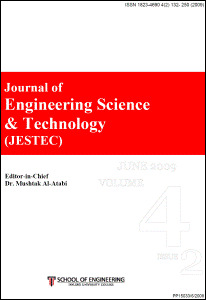Indriawati, Katherin and Saputra, Rahmat Andy and Jabal, Ayman Abo and Budiati, Titik and Biyanto, Totok R. (2012) Recent Developments In Modeling Of Monitoring In The Anaerobic Bioreactor System. Journal of Engineering Science and Technology, 7 (1). pp. 56-72. ISSN 1823-4690
|
Text
Paper 8.0 (Article of Jestec).pdf Download (435kB) |
||
![[img]](https://sipora.polije.ac.id/19232/2.hassmallThumbnailVersion/Paper%208.1%20%28Cover%20of%20Jestec%29.gif)
|
Image
Paper 8.1 (Cover of Jestec).gif Download (6kB) | Preview |
|
|
Text
Paper 8.2 (Editorial Board of Jestec).pdf Download (190kB) |
||
|
Text
Paper 8.3 (Table of content Jestec).pdf Download (191kB) |
||
|
Text
Paper 6.6 (Turnitin Jestec).pdf Download (2MB) |
||
|
Text (Hasil Peer Review)
Recent Developments in modeling of monitoring in the anaerobic bioreactor system.pdf Download (69kB) |
Abstract
Monitoring in the anaerobic bioreactor system is requiring understanding the occurred situation in the bioreactor process. Bioreactor is complex designed to accelerate waste degradation by combining attributes of the aerobic and anaerobic bioreactors involves many variables. Multivariate Statistical Process Control (MSPC) models are a statistical solution to the problem of directly calculating physical and biological properties of molecules from their physical structure. QSAR model is utilized to extract information from a set of numerical descriptors characterizing molecular structure and use this information to develop inductively a relationship between structure and property. The goal of a (MSPC) model is to replace the conventional methods univariate Statistical Process Control (SPC) to analyze the state of the multivariate process of anaerobic bioreactor. The objective of the sequential aerobic-anaerobic treatment is to cause the rapid biodegradation of degradable waste in the aerobic stage in order to reduce the production of organic acids in the anaerobic stage resulting in the earlier onset of methanogenesis. The monitoring of process uses principal component analysis (PCA) to reduce multivariate data. Further, hotelling T² values were used to monitor the quality of the bioreactor operating condition. Hence, fuzzy logic was used to determine the present condition of the bioreactor based on the value of T² related. The simulation results indicate that the offered method is able to determine four bioreactor process states, i.e. normal, organic overload, hydraulic overload, and fluctuations in temperature, with the success rate 100%.
| Item Type: | Article | ||||||||||||||||||
|---|---|---|---|---|---|---|---|---|---|---|---|---|---|---|---|---|---|---|---|
| Contributors: |
|
||||||||||||||||||
| Subjects: | 140 - Rumpun Ilmu Tanaman > 160 - Teknologi dalam Ilmu Tanaman > 163 - Teknologi Pertanian | ||||||||||||||||||
| Divisions: | Arsip Penting Dosen > Bahan P1 | ||||||||||||||||||
| Depositing User: | Dr. Titik Budiati | ||||||||||||||||||
| Date Deposited: | 30 Mar 2023 06:28 | ||||||||||||||||||
| Last Modified: | 13 Jun 2023 14:10 | ||||||||||||||||||
| URI: | https://sipora.polije.ac.id/id/eprint/19232 |
Actions (login required)
 |
View Item |


